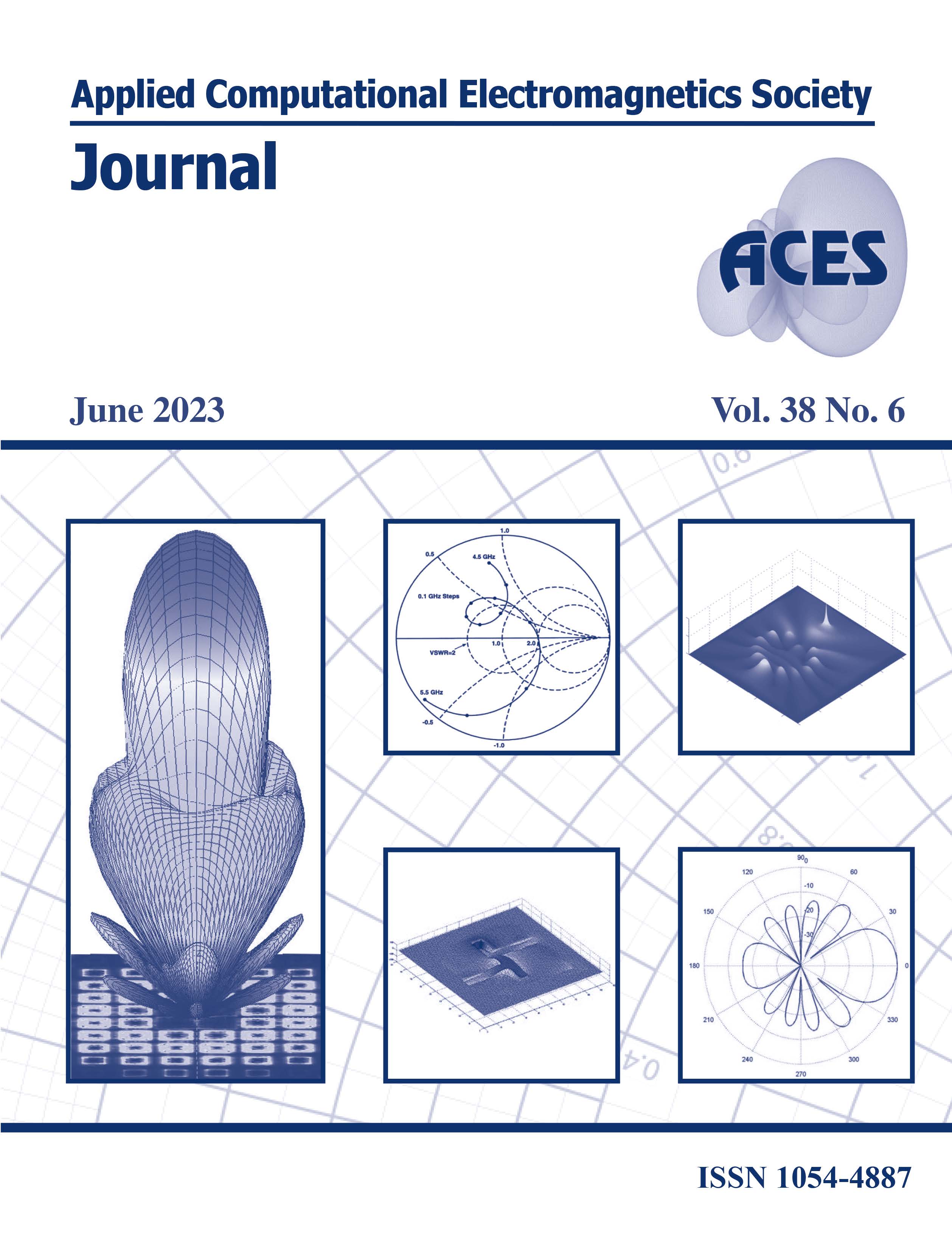Planar Antenna Design on the Characteristics of Moore Fractal-based High Impedance Surface
DOI:
https://doi.org/10.13052/2023.ACES.J.380603Keywords:
High Impedance Surface (HIS), Moore Curve Fractals, Rectangular Patch AntennaAbstract
This work presents a planar antenna with a rectangular shape designed over a Moore curve fractal-shaped High Impedance Surface (HIS). The Moore fractal geometries are space-filling curves and are useful for multiband applications. The Moore curve-shaped fractal HIS is simulated up to three iterations, and performance is examined. The proposed antenna has multiband operation within the S-band, C-band, and lower X-band frequency of operation. The antenna has a peak gain of 5.08 dB, 4.69 dB, and 5.07 dB with a Moore curve fractal HIS, with iterations 1, 2, and 3 used as the ground plane. The antenna has been analyzed regarding the reflection coefficient, radiation pattern, 3-D polar plots, and surface current distribution. With Moore curve iteration 1, a shaped HIS provides a maximum bandwidth of 740 MHz with the center frequency of 10.95 GHz, 1.24 GHz with the center frequency of 10.57 GHz, and 1.09 GHz with the center frequency of 12.5 GHz with the second and third iterations, respectively.
Downloads
References
D. F. Sievenpiper, “High impedance electromagnetic surfaces,” Ph.D. dissertation, Dept. Elect. Eng., UCLA, Los Angeles, CA, USA, 1999.
F. Yang and Y. Rahmat-Samii, ”Reflection phase characterization of an electromagnetic band-gap (EBG) surface,” IEEE Antenna Propag. Soci. Int. Symp. (IEEE Cat. No. 02CH37313), San Antonio, TX, USA, pp. 744-747, doi: 10.1109/APS.2002.1018317, 2002.
S. Clavijo, R. E. Diaz, and W. E. McKinzie, “Design methodology for Sievenpiper high-impedance surfaces: An artificial magnetic conductor for positive gain electrically small antennas,” IEEE Trans. Antennas Propag., vol. 51, no. 10, pp. 2678-2690, Oct. 2003.
F. Yang and Y. Rahmat-Samii, “Reflection phase characterizations of the EBG ground plane for low profile wire antenna applications,” IEEE Trans. Antenna Propag., vol. 51, no. 10, pp. 2691-2703, Oct. 2003.
F. Costa, A. Monorchio, S. Talarico, and F. M. Valeri, “An active high-impedance surface for low-profile tunable and steerable antennas,” IEEE Antennas Wireless Propag. Lett., vol. 7, pp. 676-680, Sep. 2008.
D. J. Kern, D. H. Werner, A. Monorchio, L. Lanuzza, and M. J. Wilhelm, “The design synthesis of multiband artificial magnetic conductors using high impedance frequency selective surfaces,” IEEE Trans. Antennas Propag., vol. 53, no. 1, pp. 8-17, Jan. 2005.
M. Hosseini, A. Pirhadi, and M. Hakkak, “Design of a non-uniform high impedance surface for a low profile antenna,” J. Electromagn. Waves Appl., vol. 20, no. 11, pp. 1455-1464, Jan. 2006.
M. Li, S.-Q. Xiao, and B.-Z. Wang, “Investigation of using high impedance surfaces for wide-angle scanning arrays,” IEEE Trans. Antenna Propag. vol. 63, no. 7, pp. 2895-2901, July 2015.
G. Gupta and A. R. Harish, “Circularly polarized antenna using a double layered via-less high impedance surface,” Microw. Opt. Technol. Lett. vol. 58, no. 2, pp. 340-343, Feb. 2016.
P. K. Panda and D. Ghosh, “Wideband bow-tie antenna with increased gain and directivity by using high impedance surface,” Int. J. RF Microw. Comput. Aided Eng., vol. 29, no. 3, pp. e21619, Mar. 2019.
A. T. Almutawa, H. Kazemi, and F. Capolino, “Analyze and design of thin planar high impedance surface as an antenna,” 2018 Int. Conf. Electromag. Adv. Appl. (ICEAA), Cartagena, Colombia, pp. 623-624, doi: 10.1109/ICEAA.2018.8520480, 2018.
G. Cheng, Y.-M. Wu, J.-X. Yin, N. Zhao, T. Qiang, and X. Lv, “Planar Luneburg lens based on the high impedance surface for effective Ku-band wave focusing,” IEEE Access, vol. 6, pp. 16942-16847, Feb. 2018.
M. M. Bait-Suwailam, I. I. Labiano, and A. Alomainy, “Impedance enhancement of textile grounded loop antenna using high-impedance surface (HIS) for healthcare applications,” Sensors, vol. 20, no. 14, p. 3809, July 2020.
J. K. Ali, “A new microstrip-fed printed slot antenna based on Moore space-filling geometry,” 2009 Loughborough Antenna & Propag. Conf., Loughborough, UK, pp. 449-452, doi: 10.1109/LAPC.2009.5352551, 2009.
M. Ali, T. Sittironnarit, V. K. Kunda, H. S. Hwang, R. A. Sadler, and G. J. Hayes, “Wideband patch antenna for 5-6 GHz WLAN applications,” IEEE Antennas and Propag. Society Int. Symp. Digest, Columbus, OH, USA, pp. 930-933, vol. 2, doi: 10.1109/APS.2003.1219387, 2003.
J. Anguera, A. Andújar, J. Jayasinghe, V. V. S. S. S. Chakravarthy, P. S. R. Chowdary, J. L. Pijoan, T. Ali, and C. Cattani, “Fractal antennas: An historical perspective,” Fractal and Fractional, vol. 4, no. 1, p. 3, Jan. 2020.




